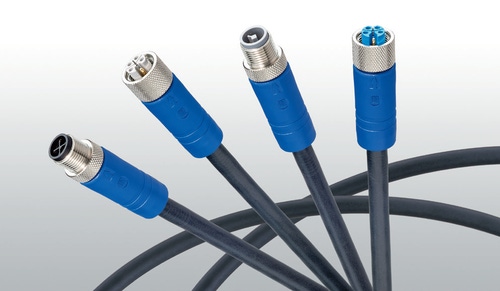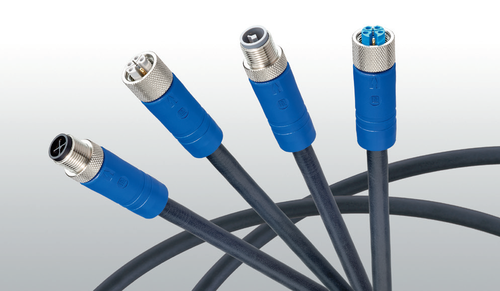How to Maximize and Modernize Food and Beverage Production Wiring
December 14, 2015

In food and beverage production, data is transmitted in the immediate vicinity of the production floor, where mechanical, thermal, and chemical stresses are prevalent. The demands on cabling are high: Engineers need cables that can withstand constant wash downs and connectors that can be submerged in liquids, while still keeping the motors and other critical components up and running. If a cabling system or Ethernet switch fails in a processing facility, the repair and labor costs alone could be 15 to 20 times the cost of the connector or cable itself -- if they can even be fixed at all. Downtime in this sector can reach overall costs of $20,000 to $30,000 per hour.
Avoid the high expenses that come with downtime by investing in automation components that function reliably, even at extreme temperatures and high pressures. Customized wiring solutions are a great option because they not only fit specific application needs, but secure the network and maximize uptime.

The evolution of wiring: From passive to active
There are two types of wiring: passive and active. With passive wiring, sensors and actuators are connected centrally with the control cabinet via separate cables, or decentrally by means of I/O modules and common power lines. Only binary or analog signals can be transmitted and read in both cases. I/O modules are more economical as neither terminal blocks nor cable glands need to be installed.
Production processes are becoming smarter with the rise of the Industrial Internet of Things (IIoT), and passive wiring is no longer sufficient to evaluate and transmit the variety of information we now have at our fingertips: status messages about the contamination level of sensors and actuators, monitoring information about operating temperatures, and data regarding the number of switching cycles. To track these key pieces of information, engineers require bidirectional data communication, otherwise known as active wiring. Ethernet, although relatively new, is rapidly becoming the preferred communication method for industrial automation, and will be used as a transmission protocol to cope with the constantly growing volume of data. Traditional, non-Ethernet, active fieldbuses will continue to be supported and designed into new systems for a variety of reasons, but the Ethernet-based systems will be more popular in future food and beverage applications.
READ MORE FOOD & BEVERAGE ARTICLES:
Selecting efficient solutions: Washdown connectors
When selecting connectors for use in food and beverage production, there are a few key features to keep in mind:
Installation: Connectors should be easy to install with standardized M8 or M12 connection technology
Reliability: Connectors should be equipped with gold-plated crimp contacts for reliable data transfer
Flexibility: Connectors should provide options for a variety of different poles and assembled actuator and sensor cord sets or connecting cables for higher flexibility
Integrity: Connectors should be vibration-proof, able to withstand cleaning with high-pressure equipment and have smooth surfaces to avoid bacteria and residue build-up
Impermeability: Resistance to aggressive chemicals and cleaning agents is crucial to avoid the degradation of the connectors
Industry certifications: Connectors should be Underwriters Laboratories (UL) certified, which means they've been approved for use in harsh and demanding industrial settings by the worldwide safety organization for electrical devices and components
Industry ratings: In addition to UL certifications, connectors should meet key industry ratings, such as IP67 for waterproof cables and connectors; IP68 for waterproof submersion; and IP69K, which approves these components for cleaning with high-pressure equipment
Temperature range: Connectors in this sector should be able to withstand temperatures of -40C to 105C
These features ensure the system can keep up with the increased data demands of IIoT and can withstand the harsh environmental conditions that are common to the factory floor.
Transmitting diverse data with I/O modules
I/O modules should support all the usual transmission protocols, such as Industrial Ethernet variants -- Profinet and Ethernet/IP -- or field bus systems -- Profibus, DeviceNet, CANopen, and AS Interface.
Optimum wiring is largely dependent on the resistance of the modules. The environmental conditions in production areas are often harsh, which means I/O modules need to have high protection ratings of up to IP69K, allowing them to be washed down using high-pressure equipment in the same way as the wash-down connectors. High-pressure cleaning is needed to ensure the factory components are sanitary and food and beverage products are safe to consume. Similar to connectors, I/O modules should be resistant to chemicals and cleaning agents, and be both vibration- and shock-proof.
The future of food and beverage with IIoT
Robust wiring solutions -- specifically connectors and I/O modules -- are critical for success in the food and beverage industry. With these solutions, sensors and actuators can be reliably connected and protected in the spray zones of production processes where conditions are harsh, demanding, and often unsanitary, ensuring production reliability. They also facilitate active wiring, which ensures smooth production processes in the face of the large amounts of data that are rising with the onset of IIoT. As IIoT becomes even more integrated into food and beverage production, all system components will be seamlessly connected, and the failure of one component will inhibit the productivity of the rest of the factory floor. Having reliable and robust connector and module solutions will be even more important for minimizing downtime of the entire production system and avoiding the high expenses that come with repairs.
Toni Hauert is business development manager at Belden ICOS division, responsible for the strategic direction of I/O network systems. Hauert graduated from the Flensburg University of Applied Sciences with a major in business administration. Before joining Belden in 2013 he worked as sales manager at wenglor sensoric gmbh for eight years.
Like reading Design News? Then have our content delivered to your inbox every day by registering with DesignNews.com and signing up for Design News Daily plus our other e-newsletters. Register here!

Design engineers and professionals, the West Coast's most important design, innovation, and manufacturing event, Pacific Design & Manufacturing, is taking place in Anaheim, Feb. 9-11, 2016. A Design News event, Pacific Design & Manufacturing is your chance to meet qualified suppliers, get hands-on access to the latest technologies, be informed from a world-class conference program, and expand your network. (You might even meet a Design News editor.) Learn more about Pacific Design & Manufacturing here.
About the Author(s)
You May Also Like





